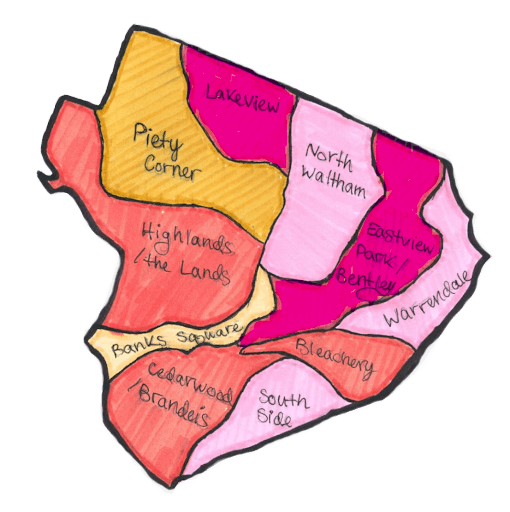Rent prices burden Waltham community, drive out many residents
As more students seek off-campus housing, costs of living rise, and ultimately produce gaps in affordability that the community is unable to meet.
Editor’s note—Reporting for this story was originally completed in the 2022 fall semester for a JOUR 89A class project titled “Smells Like Zine Spirit.”
As Brandeis class sizes grow larger and larger, the housing lottery has become even more competitive, pushing many students off campus. But the cost of living in Waltham, coupled with the increased demand on the rental market that comes from Brandeis and Bentley Universities, has driven many who grew up in Waltham to search for housing in different communities. This especially poses a risk to renters — and in a city like Waltham, comprising 50% renters, it can be difficult to compete with high property and rent values.
According to a Oct. 19 interview with Josh Kastorf of Grouches of Waltham — an independent group that covers local government, city council meetings, issues pertaining to the Waltham community, and local happenings — the “people who are getting priced out are not low income people.”
The current housing costs push everyone out, making “it impossible to have an intergenerational community,” Kastorf said. As he put it, people grow up here and don’t know if they can live in Waltham when they retire or if their kids can live here when they grow up — few people are permanent.

RENTALS: Properties near Brandeis and Bentley University tend to be among the more expensive properties in the area. Data was collected from neighborhoodscout.com.
There are numerous organizations within Waltham, such as the Waltham Housing Authority, that work to address housing disparities and to mediate the impermanence of the community. Affordable and low income housing offerings aid in creating more options for people, but the criteria for affordable and low income housing itself is very specific and not available to all families who could benefit from these options.
Affordable and low income housing rates are established based upon Area Median Income figures of the average working family that are collected by the U.S. Department of Housing and Urban Development and the U.S. Census Bureau.
However, per Councilor Jonathan Paz (Ward 9), the term “average” can skew these figures. “It’s not just about how

do we create more affordable housing, it’s how do we define affordable and how do we preserve what’s affordable and what’s dignified,” Paz said in an Oct. 11 interview with Channel 781 News. There are also numerous basic living expenses — facilities, food, transportation, childcare, etc. — that leave families “rent burdened.”
“Our mission is to provide safe, clean, affordable housing for people so they can live with some sort of dignity, comfort, and safety,” the Executive Director of the WHA John Gollinger said. The WHA provides low income housing to people at or below the 30% AMI rate, according to Gollinger. In 2020 Waltham had a median income rate of $95,851, according to the U.S. Census Bureau. The bureau defines the average family size in Waltham as 3.02, and a family of three can have a maximum income of $51,750 to apply for a Section 8 Housing Choice Voucher.
Currently, the WHA manages 22 sites with over 800 units, the newest of which date back to the late 1970s, according to Gollinger. Even if the Waltham city government found a way to double the amount of affordable and low income housing in the city, it would not even begin to “put a dent into what is needed in the community,” Gollinger said.
Despite the growing need for affordable housing, the WHA doesn’t acquire new properties because they struggle with staffing and resources for the current properties that they manage. The majority of their budget, therefore, goes toward property maintenance and upgrades, according to Gollinger. Other organizations that are either government-run or non-profits could fill in the slack and adapt vacant properties, but this would require a lot of work that the city has not necessarily shown interest in supporting, Kastorf explained.
Over the years, numerous people have proposed refurbishing abandoned spaces like the Company F. State Armory into affordable housing units. Most recently Daria Gere — the executive director at the Waltham Alliance for Teaching, Community Organizing and Housing, a Community Development Corporation — gave a presentation to the 2020 ad-hoc committee on affordable housing. WATCH CDC is a local organization that advocates for affordable housing and “empowerment through civic engagement,” per the organization’s website. During her presentation, Gere stated her agency’s intention to develop the vacant armory.
This proposal was essentially shot down on procedural grounds because the nonprofit developer failed to provide a signed purchase and sale agreement. “In other words… it was killed by the city council, because supposedly the application was out of order,” Kastorf said.
“I think that realistically, the only way to fix our housing problems is to build new housing,” Kastorf said. Another potential solution that has been proposed by a variety of advocates over the years, most recently WATCH CDC, is to focus efforts on redeveloping vacant properties. Both of these solutions would require ongoing cooperation with developers — something the city has struggled to do in the past.
Public housing is a critical issue, Gollinger explained. Having adequate housing for families is “such an important factor of our lives.” He continued, “we need to bring more people into our profession who have ideas [on how to] alleviate… the pressing issues that follow when you have an inadequate housing supply for people.”
Editor's note — A previous version of this article incorrectly insinuated that Brandeis students were largely responsible for the shift in rent prices and avalability in the Waltham community. On Feb. 7, this was corrected.




Please note All comments are eligible for publication in The Justice.